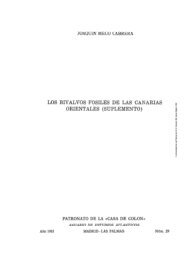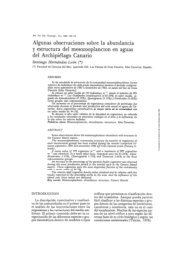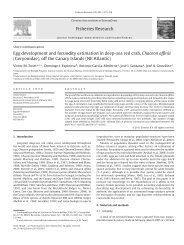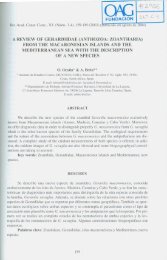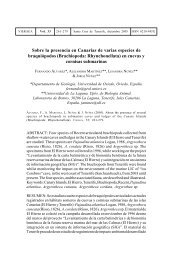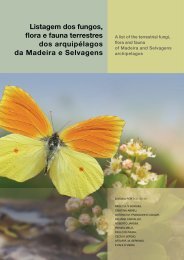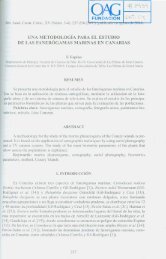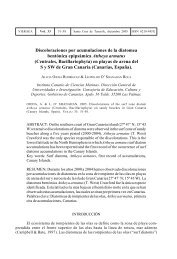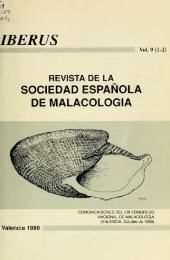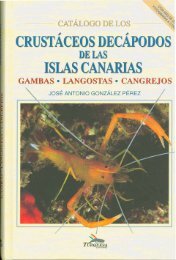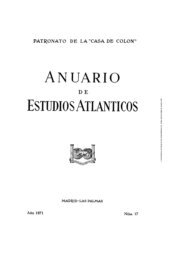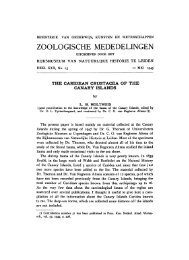Restoration of Cymodocea nodosa seagrass meadows ... - redmic
Restoration of Cymodocea nodosa seagrass meadows ... - redmic
Restoration of Cymodocea nodosa seagrass meadows ... - redmic
You also want an ePaper? Increase the reach of your titles
YUMPU automatically turns print PDFs into web optimized ePapers that Google loves.
Article in press - uncorrected pro<strong>of</strong><br />
Botanica Marina 53 (2010): 173–181 2010 by Walter de Gruyter • Berlin • New York. DOI 10.1515/BOT.2010.019<br />
<strong>Restoration</strong> <strong>of</strong> <strong>Cymodocea</strong> <strong>nodosa</strong> <strong>seagrass</strong> <strong>meadows</strong><br />
through seed propagation: germination in vitro, seedling<br />
culture and field transplants<br />
Maite E. Zarranz 1,2 , Nieves González-Henríquez 2 ,<br />
Pilar García-Jiménez 1 and Rafael R. Robaina 1, *<br />
1 Departamento de Biología, Facultad de Ciencias del Mar,<br />
Universidad de Las Palmas de Gran Canaria, 35017 Las<br />
Palmas de Gran Canaria, Canary Islands, Spain,<br />
e-mail: rrobaina@dbio.ulpgc.es<br />
2 Instituto Canario de Ciencias Marinas, Muelle de Taliarte,<br />
35200 Telde, Gran Canaria, Canary Islands, Spain<br />
* Corresponding author<br />
Abstract<br />
<strong>Cymodocea</strong> <strong>nodosa</strong>, a marine angiosperm, an ecosystem<br />
engineer in the Mediterranean Sea and the Northwest Atlantic<br />
Ocean; however, as in other <strong>seagrass</strong>es <strong>meadows</strong> worldwide,<br />
the swards are actually declining due to increasing<br />
human pressures. Hence, we have developed an effective<br />
propagation methodology that provides C. <strong>nodosa</strong> seedlings<br />
for <strong>seagrass</strong> meadow restoration and conservation. This<br />
method consists <strong>of</strong>: i) germination <strong>of</strong> wild-collected seeds<br />
under hyposaline conditions, ii) acclimation <strong>of</strong> germinated<br />
seedling in tanks (1.6 m 3 ) until there are two shoots per<br />
seedling (;30 days), and iii) transplantation <strong>of</strong> acclimated<br />
seedlings to the field in dense groups. Our field outplants<br />
withstood herbivore activity and physical disturbance during<br />
the winter season, and propagated vegetatively, resulting in<br />
the spread and establishment <strong>of</strong> a new patch that has persisted<br />
for nine months.<br />
Keywords: acclimation; germination; hyposalinity;<br />
restoration; <strong>seagrass</strong>es.<br />
Introduction<br />
Concern has arisen over the decline <strong>of</strong> <strong>seagrass</strong> ecosystems<br />
worldwide as a result <strong>of</strong> adverse human activities in coastal<br />
areas (Walker and McComb 1992, Duarte et al. 2004, Orth<br />
et al. 2006, Duarte and Gattuso 2008, Hughes et al. 2009).<br />
<strong>Restoration</strong> and mitigation programs have been carried out<br />
since the mid-20th century (Addy 1947, Phillips 1974, Gordon<br />
1996, Fonseca et al. 1998, Johansson and Greening<br />
2000) using plant material collected from donor <strong>meadows</strong><br />
(Orth et al. 1999, Heidelbaugh et al. 2000, Van Keulen et al.<br />
2003, Paling et al. 2007, Park and Lee 2007). Because <strong>of</strong><br />
the logistical burden associated with moving mature plants,<br />
the use <strong>of</strong> seeds and seedlings germinated in vitro is widely<br />
considered to be a more cost-effective alternative (Thorhaug<br />
1985, Orth et al. 1994, 2000, 2009, Balestri et al. 1998, Kirkman<br />
1998, Harwell and Orth 1999, Granger et al. 2002, Pickerell<br />
et al. 2005, Ailstock and Shafer 2006). This method<br />
is also likely to avoid damage to donor <strong>meadows</strong> from which<br />
planting units (comprising adult plants) are extracted (Christensen<br />
et al. 2004, Seddon 2004); transplanting seeds and<br />
seedlings also increases genetic variability in the receiving<br />
population that is to be restored or replanted (Waycott 1995,<br />
Williams and Orth 1998, Procaccini and Piazzi 2001, Reusch<br />
2002).<br />
The <strong>seagrass</strong> <strong>Cymodocea</strong> <strong>nodosa</strong> (Uchria) Ascherson<br />
forms dense, shallow water <strong>meadows</strong> (between 2 and 35 m<br />
deep) across the Mediterranean Sea and the Northwest Atlantic<br />
Ocean, including the Canary Islands (Reyes et al. 1995,<br />
Pavón-Salas et al. 2000, Alberto et al. 2008, Cunha and<br />
Araújo 2009). This marine angiosperm produces permanent<br />
seed banks throughout the year (Caye and Meinesz 1985,<br />
Caye et al. 1992, Terrados 1993, Reyes et al. 1995), but<br />
germination rates in nature may be variable. Pirc et al. (1986)<br />
and Reyes et al. (1995) reported germination rates as high<br />
as 50%, but sometimes the rate is zero (Caye and Meinesz<br />
1985); moreover, once seeds have germinated, their fate is<br />
mixed, and actual recruitment may be low (Caye and Meinesz<br />
1986, Buia and Mazzella 1991, Terrados 1993, Reyes<br />
et al. 1995).<br />
The sensitivity <strong>of</strong> this species to human impacts has been<br />
documented in several studies (Terrados and Ross 1995,<br />
Vergara-Martín et al. 2005, Fernández-Torquemada and<br />
Sánchez-Lizaso 2006), and a restoration protocol for conservation<br />
is urgently required. To this end, two studies have<br />
been performed to transplant <strong>Cymodocea</strong> <strong>nodosa</strong> adult plants<br />
from donor to recipient <strong>meadows</strong> (Curiel et al. 2003, Ruiz<br />
de la Rosa et al. 2006), but there have been no attempts to<br />
transplant seedlings.<br />
Given the fragility <strong>of</strong> <strong>Cymodocea</strong> <strong>nodosa</strong> in the face <strong>of</strong><br />
human impacts, and its low germination and seedling survival<br />
rates in nature (Caye and Meinesz 1985, Buia and Mazzella<br />
1991), we believe that increasing germination potential<br />
and seedling survival would be an appropriate strategy for<br />
the conservation <strong>of</strong> this species and its habitat. In this study,<br />
we developed a methodology for propagation <strong>of</strong> C. <strong>nodosa</strong><br />
seeds under laboratory conditions, the acclimation <strong>of</strong> seedlings<br />
to enhance biomass development, and outplanting in<br />
the wild under prevailing conditions ensuring enhanced survival<br />
rates. This methodology provides seedlings that might<br />
be employed for the restoration <strong>of</strong> small but strategically<br />
important degraded areas, or to improve the conservation <strong>of</strong><br />
established <strong>meadows</strong> by introducing genetic variation.<br />
2010/63
Article in press - uncorrected pro<strong>of</strong><br />
174 M.E. Zarranz et al.: Propagation <strong>of</strong> <strong>Cymodocea</strong> <strong>nodosa</strong> seeds in vitro<br />
Materials and methods<br />
Seed collection and culture methods<br />
The seeds used in this study were collected by SCUBA diving<br />
(May 2007) in a <strong>Cymodocea</strong> <strong>nodosa</strong> meadow located <strong>of</strong>f<br />
Juan Grande on the southeastern coast <strong>of</strong> Gran Canaria<br />
(27845945.480 N; 15833904.010 W, Spain). Seeds were found<br />
either on the surface <strong>of</strong> the seafloor or buried a few cm<br />
beneath the sediment. Once collected, seeds were placed in<br />
a nylon net (0.2-mm mesh), which kept them wet during<br />
transfer to the laboratory (within 2 h <strong>of</strong> collection).<br />
To prevent overgrowth by epiphytes, seeds were gently<br />
cleaned with a tooth brush and then submerged for 10 min<br />
in a 10% (v:v) commercial bleach solution made up in autoclaved<br />
seawater (a drop <strong>of</strong> Tween 80 was used as surfactant).<br />
Seeds were then washed three times in autoclaved seawater.<br />
Culture vessels (Magenta R – G7 300 ml Sigma Co., Chicago,<br />
IL, USA) were filled with 40 cc <strong>of</strong> autoclaved sand and<br />
200 ml <strong>of</strong> liquid culture medium. We used PES culture medium<br />
(Provasoli 1968), but substituted ammonium for nitrate<br />
and mono-potassium phosphate for glycerol phosphate,<br />
based on previous experience with <strong>Cymodocea</strong> <strong>nodosa</strong><br />
explant cultures (see García-Jiménez et al. 2006). The salinities<br />
<strong>of</strong> the seawater and culture medium in culture matched<br />
ambient seawater (36.6 psu), except where otherwise stated.<br />
Cultures in the laboratory were placed inside a growth<br />
chamber at 248C, with a 16:8 light:dark photoperiod and<br />
30 mmol photons m -2 s -1 irradiance at the level <strong>of</strong> the culture<br />
vessels.<br />
Induction <strong>of</strong> germination<br />
Hyposaline shock was used to induce germination. This<br />
treatment facilitates the imbibition <strong>of</strong> water needed for seed<br />
germination (Caye and Meinesz 1986, Caye et al. 1992).<br />
Seawater diluted with double distilled water was used to<br />
achieve the different salinity levels: 5, 11 and 18 psu, while<br />
36 psu was used as a control treatment (Robaina et al.<br />
1990a,b). Thirteen culture vessels with two seeds in each<br />
(i.e., 26 seeds per treatment) were used for each treatment to<br />
determine the effects <strong>of</strong> hyposaline treatments on germination.<br />
Thirty days (based on preliminary experiments) after<br />
hyposalinity shock, all seeds and seedlings were transferred<br />
to 36.6 psu medium to acclimate them to ambient salinity,<br />
and three different stages <strong>of</strong> development were monitored:<br />
stage I, germinating seeds (Figure 1A); stage II, stage with<br />
emergent green cotyledon (Figure 1B), and stage III, development<br />
<strong>of</strong> first new leaves (Figure 1C). These three stages<br />
<strong>of</strong> development extended over three months following germination<br />
induction.<br />
Acclimation <strong>of</strong> seedlings<br />
All viable seedlings that had reached stage III after the induction<br />
procedure were placed into holding tanks (1.6 m 3 ) with<br />
sand covering the bottom (ca. 10% <strong>of</strong> the total volume,<br />
15 cm depth, no nutrients added) under open, continuous<br />
seawater flow, at an average temperature <strong>of</strong> 218C and an<br />
average irradiance <strong>of</strong> 60 mmol photons m -2 s -1 (Figure 1D).<br />
Leaf and root growth and shoot and root emergence were<br />
monitored fortnightly (ns30) while plants were in the holding<br />
tanks (45 days) prior to transplantation to the field.<br />
Transplants <strong>of</strong> developed seedlings to the field<br />
Once plants had developed sufficient roots and shoots for<br />
transplantion (30–45 days), they were transferred to the field.<br />
Two pilot transplant treatments (May 2008) were compared:<br />
i) seedlings scattered on nylon nets tied with thread<br />
(20=20 cm nets with 20 sown seedlings in each, ns60, densitys500<br />
seedlings m -2 ), and ii) seedlings clustered in biodegradable<br />
trays made <strong>of</strong> compressed coconut fiber dust<br />
(trays hereafter), which allowed a healthy root growth in 12<br />
compartments <strong>of</strong> 3=3=5 cm, with three seedlings per compartment<br />
and up to 36 seedlings per tray, ns108, densitys<br />
3333 seedlings m -2 ). A set <strong>of</strong> seedlings (ns76) was planted<br />
directly in the sediment; (densitys3377 seedlings m -2 ). The<br />
nylon nets and trays were anchored using metal staples. For<br />
these pilot transplanting experiments, a sheltered location<br />
(6 m depth, along the edges <strong>of</strong> a natural meadow,<br />
27859920.440 N; 15822912.450 W, Gran Canaria, Spain) was<br />
selected to improve chances <strong>of</strong> establishment and for monitoring<br />
purposes. Over nine months, we monitored % survival<br />
(as % seedlings remaining in the patch and apparently pigmented<br />
and healthy) and average leaf length (cm) for each<br />
transplant methodology and for clustered seedlings that had<br />
been planted directly in the sediment.<br />
Statistics<br />
Statistical design and calculations were carried out using<br />
SPSS 13.0 for Windows (SPSS Inc., Chicago, IL, USA).<br />
Contingency table analyses were used to detect differences<br />
on germination and further growth in 18 psu salinity and the<br />
rest <strong>of</strong> the treatments, assuming H 0:p1, proportion in<br />
18 psusp2, proportion in other salinity treatments, and the<br />
alternative hypothesis was: p1/p2; the test statistic was x 2 .<br />
Bonferroni correction to the experiment-wise error rate (5%)<br />
was applied to reduce the type 1 error rate in a set<br />
<strong>of</strong> multiple comparisons. In the outplanting experiment,<br />
ANOVA was used to compare the number <strong>of</strong> seedlings<br />
remaining each month between trays and nylon nets.<br />
Results<br />
We found an inverse relationship between culture medium<br />
salinity and seed germination (Table 1). The lower the salinity,<br />
the greater the germination rate. However, responses in<br />
treatments 5, 11 and 18 psu were not significantly different<br />
at the end <strong>of</strong> the experiment; all salinities induced seed germination<br />
within a month. Significantly lower germination<br />
occurred in the control treatment (36 psu). Regardless <strong>of</strong><br />
treatment, 60% <strong>of</strong> cultivated seeds germinated after three<br />
months (in 82.6% <strong>of</strong> culture vessels).<br />
The reduced salinity treatments inhibited post-germination<br />
development (Table 1). None <strong>of</strong> the seeds germinated at
Article in press - uncorrected pro<strong>of</strong><br />
M.E. Zarranz et al.: Propagation <strong>of</strong> <strong>Cymodocea</strong> <strong>nodosa</strong> seeds in vitro 175<br />
Figure 1 <strong>Cymodocea</strong> <strong>nodosa</strong>.<br />
(A–C) Three different stages <strong>of</strong> development: (A) Stage I, germinating seeds (arrow), bars0.5 cm; (B) Stage II, elongation <strong>of</strong> cotyledon,<br />
bars1 cm; (C) Stage III, development <strong>of</strong> first new leaves (arrow), bars1 cm; (D–G) Acclimation: (D–E) Seedlings acclimating in aquaria<br />
or tanks; (D) bars0.5 m; (E) bars0.4 m; (F–G) Seedlings with leaves attached to a young incipient rhizome with up to two leaves and<br />
root development after 30 days <strong>of</strong> acclimation; (H–J) Field transplant. Persistent patch formed from clustered seedlings transferred directly<br />
into the sediment: (H) Plants at day zero, bars5 cm; (I) Plants at day 30. Note plagiotropic rhizome development, bars4 cm; (J) Plants at<br />
month 6, bars5 cm.<br />
5 psu reached stage II and III in vitro (Figure 1B, C). Considering<br />
both germination percentage and further development<br />
up to stage III, the best germination and seedling<br />
development was achieved at salinities <strong>of</strong> 11 and 18 psu<br />
(slightly higher in the latter), as the seeds apparently acclimated<br />
in vitro and even generated two new leaves (Figure<br />
1C).<br />
All seeds that reached stage III developed well after transfer<br />
to continuous seawater-flow tanks (Figure 1D, E), regardless<br />
<strong>of</strong> whether or not they had germinated in media at 11,<br />
18 or 36 psu. Seedlings grew and developed new roots,<br />
shoots and leaves during the whole acclimation period (Figure<br />
2A, D). At day 30, seedlings had developed 4.20"0.95<br />
leaves, 1.40"0.50 shoots and 4.05"1.19 roots, with average<br />
leaf and root lengths <strong>of</strong> 22.25"6.45 cm and 7.46"2.90 cm,<br />
respectively (Figure 2A–D).<br />
After outplanting to the sea, there were no significant differences<br />
between the number <strong>of</strong> seeds surviving in trays and<br />
nylon nets until month five (Figure 3A). Thereafter, seeds<br />
attached to nets died and only few necrotic fragments<br />
remained attached, while seedlings in the trays remained (ca.<br />
40% survival). The best results were obtained by direct transplantation<br />
into the substratum (Figure 3A). These seedlings<br />
survived a winter and are now almost a year old, forming a<br />
small patch in which new plagiotropic rhizome tissue was<br />
observed (Figure 1H–J). Leaf length was very varied when
Article in press - uncorrected pro<strong>of</strong><br />
176 M.E. Zarranz et al.: Propagation <strong>of</strong> <strong>Cymodocea</strong> <strong>nodosa</strong> seeds in vitro<br />
Table 1 <strong>Cymodocea</strong> <strong>nodosa</strong>: effect <strong>of</strong> salinity treatments on germination and further growth to reach development stage III (3 months).<br />
Month 1 Month 2 Month 3<br />
Salinity (psu) 5 11 18 36 5 11 18 36 5 11 18 36<br />
Germination (n) 12* 12* 7 – 12 12 12 5** 12 12 13 6**<br />
Germination (%) 92.3 92.3 53.84 – 92.3 92.3 92.3 38.46 92.3 92.3 100 46.15<br />
Stage III (n) – 1 1 – – 7 11 5** – 9 12 6**<br />
Stage III (%) – 7.69 7.69 – – 53.84 84.61 38.46 – 69.23 92.3 23.07<br />
Percentage germination: number <strong>of</strong> culture vessels in which germinating seeds were observed among total number <strong>of</strong> culture vessels (13<br />
vessels per treatment; total seedss104). Percentage stage III: number <strong>of</strong> vessels in which germinated seeds reached stage III (i.e., seedlings<br />
with one shoot and two leaves). Experiment-wise error rate is 0.05. Comparison error rate is experiment-wise error rate/number <strong>of</strong> comparisons<br />
(Bonferroni correction). * , ** Indicates significant differences between a treatment and 18 psu treatment in each month (p-0.017<br />
and p-0.01, respectively; –, not detected).<br />
seedlings were transplanted into the sea, but finally stabilized<br />
at the end <strong>of</strong> the experiment (Figure 3B).<br />
Discussion<br />
The importance <strong>of</strong> <strong>seagrass</strong> beds has been recognised worldwide<br />
for their multiple ecological roles in estuarine and<br />
coastal systems, where they act as nursery habitat and<br />
enhance coastal erosion protection (Mena et al. 1993, Terrados<br />
and Borum 2004). However, estuaries and coasts and<br />
the species that inhabit them are vulnerable to increasing<br />
human pressure (den Hartog 1996, Orth et al. 2006, Ralph<br />
et al. 2006, Hughes et al. 2009) and habitat conditions have<br />
substantially deteriorated over the last two decades (Duarte<br />
et al. 2004). Application <strong>of</strong> diverse management strategies<br />
Figure 2 <strong>Cymodocea</strong> <strong>nodosa</strong>: plant development during acclimation.<br />
(A–B) Leaf and root lengths over 45 days. (C–D) Shoot and root regeneration over 45 days seedling acclimation (values are means"SD,<br />
ns30).
Article in press - uncorrected pro<strong>of</strong><br />
M.E. Zarranz et al.: Propagation <strong>of</strong> <strong>Cymodocea</strong> <strong>nodosa</strong> seeds in vitro 177<br />
Figure 3 <strong>Cymodocea</strong> <strong>nodosa</strong>: field trials.<br />
(A) Survival (%). (B) Average leaf length (cm) <strong>of</strong> acclimated plantlets transferred to a natural meadow (27859920.440 N; 15822912.450 W,<br />
Gran Canaria, Spain) using three different transplant methodologies: a) seedlings scattered on nylon nets (rs3, ns60), b) seedlings clustered<br />
in biodegradable trays (rs3, ns108), and c) seedlings planted directly into the sediment (ns76). Seedling monitoring was performed over<br />
nine months (values are means"SE).<br />
for the conservation <strong>of</strong> these ecosystems is a pressing<br />
requirement (Erftemeijer et al. 2006). In Tampa Bay (Florida),<br />
control <strong>of</strong> water quality in Thalassia testudinum Banks<br />
ex Konig habitats allowed recuperation <strong>of</strong> <strong>meadows</strong>, which<br />
increased in area from 8800 ha in 1982 to 10,930 ha in 1997<br />
(Johansson and Greening 2000). Rehabilitation, restoration<br />
and mitigation programs have been carried out worldwide<br />
with different species and with varying degrees <strong>of</strong> success<br />
(Lord et al. 1999, Fonseca et al. 2000, Van Katwijk 2003,<br />
Seddon 2004, Paling et al. 2007). As for other <strong>seagrass</strong><br />
species, <strong>Cymodocea</strong> <strong>nodosa</strong> is affected by human impacts<br />
(Vergara-Martín et al. 2005, Fernández-Torquemada and<br />
Sánchez-Lizaso 2006), and some efforts have been made to<br />
protect and conserve them. At the present time, C. <strong>nodosa</strong><br />
is included in the Catalogue <strong>of</strong> Endangered Canarian Species<br />
(BOC 2001, decree 151/2001), and their habitat is protected<br />
by the EU in the Habitats Directive (Council Directive 92/<br />
43/EEC).<br />
In this work, we have developed a propagation protocol<br />
for <strong>Cymodocea</strong> <strong>nodosa</strong> seeds that may be useful for restoration<br />
and conservation programs. The procedure includes i)<br />
germination <strong>of</strong> seeds in vitro, ii) acclimation and further<br />
growth <strong>of</strong> seedlings in tanks, and iii) their later transference<br />
to coastal marine habitats.<br />
Propagation protocol for <strong>Cymodocea</strong> <strong>nodosa</strong><br />
Germination <strong>of</strong> collected seeds under hyposaline<br />
treatments In <strong>Cymodocea</strong> <strong>nodosa</strong> from the Canary<br />
Islands, optimal seed germination occurred at 50% <strong>of</strong> ambi-
Article in press - uncorrected pro<strong>of</strong><br />
178 M.E. Zarranz et al.: Propagation <strong>of</strong> <strong>Cymodocea</strong> <strong>nodosa</strong> seeds in vitro<br />
ent salinity (36 psu), although equivalent effects may be<br />
obtained with salinity as low as 11 psu. Our results are congruent<br />
with other <strong>seagrass</strong> studies that have reported hyposaline<br />
conditions to be favorable for the germination <strong>of</strong> seeds<br />
(Caye and Meinez 1986 and Caye et al. 1992 for C. <strong>nodosa</strong>;<br />
Hootsmans et al. 1987 for Zostera marina L. and for Z. noltii<br />
Hornem.; Harrison 1991 for Z. marina; Conacher et al. 1994<br />
for Z. capricorni Aschers.; Ailstock and Shafer 2006 for<br />
Ruppia maritima L. and for Potamogeton perfoliatus L.;<br />
Alexandre et al. 2006 for Z. marina).<br />
The number <strong>of</strong> germinated seeds eventually produced<br />
through exposure to hyposaline shock (5, 11, 18 psu) was<br />
significantly higher than that in non-shocked treatments<br />
(36 psu). However, it is important to note that the highest<br />
germination rates did not necessarily provide the highest<br />
number <strong>of</strong> seedlings for further propagation. At 5 psu, <strong>Cymodocea</strong><br />
<strong>nodosa</strong> seeds had the highest percentage germination<br />
in the first month, but further development <strong>of</strong> the seedlings<br />
was restricted at this low salinity (Table 1). There may be<br />
an optimal hyposaline treatment for each species that should<br />
be determined before proceeding. Moreover, temperature,<br />
light or even chemical treatments should not be disregarded<br />
as effective methods to break seed dormancy (Hilhorst and<br />
Karssen 1992). Considering both germination and seedling<br />
viability after hyposaline treatment, 11 and 18 psu (slightly<br />
better at the higher salinity) appeared to be suitable for further<br />
seedling propagation. The germination <strong>of</strong> seeds in<br />
enriched seawater (modified PES) and 50% <strong>of</strong> normal salinity,<br />
with further salinity increases to 36 psu after 30 days in<br />
culture, supported a transition rate <strong>of</strong> 54% from germination<br />
to stage III <strong>of</strong> development (92.3% germinated individuals<br />
reached stage III <strong>of</strong> development, Figure 1C).<br />
Acclimation <strong>of</strong> germinated seeds in tanks Acclimation<br />
is considered a mandatory step when propagating terrestrial<br />
plants using in vitro techniques, since plants derived<br />
from cell cultures under controlled conditions may be<br />
shocked when transferred directly to the field (Pospísˇilová et<br />
al. 1999). The acclimation <strong>of</strong> <strong>seagrass</strong> seedlings to optimize<br />
transplantation survival and growth has been emphasized in<br />
previous work (Meinesz et al. 1993, Bird et al. 1994, Woodhead<br />
and Bird 1998). However, it is also important to use<br />
the minimum feasible acclimation-period to make the protocol<br />
more cost-effective. For this reason, we consider a 30day<br />
period sufficient to produce healthy <strong>Cymodocea</strong> <strong>nodosa</strong><br />
seedlings (100% <strong>of</strong> germinated seed) ready for transplantion<br />
to the natural environment (Figure 1F). By this time, we had<br />
produced seedlings with up to four leaves ()20 cm long)<br />
and substantial root development (up to four single roots and<br />
7 cm long) (Figures 1F, G and 2).<br />
Even though previous authors have germinated <strong>Cymodocea</strong><br />
<strong>nodosa</strong> seeds under laboratory conditions (Caye and<br />
Meinesz 1986, Caye et al. 1992), further growth in these<br />
earlier works was limited, with seedling death after three to<br />
four months (Pirc et al. 1986, Buia and Mazzella 1991). The<br />
propagation systems used in our work (see Materials and<br />
methods) allow germination and continuous growth <strong>of</strong> seed-<br />
lings, producing healthy plants ready for transplant in a fourmonth<br />
period.<br />
Field transplants Use <strong>of</strong> seeds and seedlings in restoration<br />
programs has been considered as a cost effective technique<br />
that could introduce genetic variability into damaged<br />
<strong>meadows</strong> (Orth et al. 2000, Procaccini and Piazzi 2001, Ailstock<br />
and Shafer 2006). Previous works on seedling transplantation<br />
have experienced problems with anchoring, and<br />
different attachment protocols have been developed to settle<br />
seedlings into the sediment (Meinesz et al. 1993, Kirkman<br />
1998, Woodhead and Bird 1998, Seddon et al. 2004, Wear<br />
et al. 2006). Perhaps unexpectedly, our results suggest that<br />
anchoring <strong>of</strong> seedlings and plantlets might not be so critical<br />
for <strong>Cymodocea</strong> <strong>nodosa</strong> when seedlings are transplanted to a<br />
sheltered place without any anchoring method, as seen for<br />
seedlings directly planted into the sediment (Figure 3A).<br />
These seedlings developed plagiotropic rhizomes one month<br />
after transplantation (Figure 1I). According to Kirkman<br />
(1998) and Marbá et al. (2004), the development <strong>of</strong> plagiotropic<br />
rizhomes signifies the establishment <strong>of</strong> vegetative<br />
clonal growth necessary for the formation <strong>of</strong> new patches.<br />
This predicts great success for the future survival <strong>of</strong> transplanted<br />
seedlings; Marbá et al. (2004) reported that 50–70%<br />
<strong>of</strong> <strong>seagrass</strong> seedlings die in nature before clonal growth<br />
begins. Furthermore, clonal growth allows the accumulation<br />
<strong>of</strong> carbon and mineral nutrients to maintain growth in unfavorable<br />
seasons and for resource allocation in the face <strong>of</strong><br />
tissue loss to grazing (Vergés et al. 2008).<br />
Our field observations (i.e., bites on the leaf) pointed to<br />
herbivory as a possible explanation for the highly variable<br />
leaf lengths observed in transplanted seedlings (Figure 3B).<br />
We believe that clustered seedlings in the field and the resulting<br />
development <strong>of</strong> plagiotropic rhizome may also have mitigated<br />
herbivore attack, as was the case for Posidonia sp. in<br />
Western Australia (Kirkman 1998). This may help explain<br />
higher success when seedlings were clustered at an initial<br />
density <strong>of</strong> ;3000 s m -2 (i.e., in trays and direct transplanting<br />
methods, Figure 3A).<br />
Acknowledgements<br />
This work was supported by the Autonomous Government <strong>of</strong> the<br />
Canary Islands (Plan de Restauración de Sebadales de Canarias),<br />
which also provided a scholarship for M.E. Zarranz. We thank Dr.<br />
Mark Fonseca (NOAA) and Dr. Eric Bunn (KPBG) for their critical<br />
reviews <strong>of</strong> this manuscript.<br />
References<br />
Addy, C.E. 1947. Eelgrass planting guide. Mar. Conserv. 24: 16–17.<br />
Ailstock, S. and D. Shafer. 2006. Protocol for large-scale collection,<br />
processing, and storage <strong>of</strong> seeds <strong>of</strong> two mesohaline submerged<br />
aquatic plant species. ERDC/TN SAV-06-3, U.S. Army Engineer<br />
Research and Development Center, Vicksburg, MS. p. 8.<br />
Alberto, F., S. Massa, P. Manent, E. Diaz-Almela, S. Arnaud-Haond,<br />
C.M. Duarte and E.A. Serrão. 2008. Genetic differentiation and<br />
secondary contact zone in the <strong>seagrass</strong> <strong>Cymodocea</strong> <strong>nodosa</strong>
across the Mediterranean-Atlantic transition zone. J. Biogeography<br />
35: 1270–1294.<br />
Alexandre, A., S. Cabaco, ¸ R. Santos and E.A. Serrão. 2006. Timing<br />
and success <strong>of</strong> reproductive stages in the <strong>seagrass</strong> Zostera noltii.<br />
Aquat. Bot. 85: 219–223.<br />
Balestri, E., L. Piazzi and F. Cinelli. 1998. Survival and growth <strong>of</strong><br />
transplanted and natural seedlings <strong>of</strong> Posidonia oceanica (L.)<br />
Delile in a damaged coastal area. J. Exp. Mar. Biol. Ecol. 228:<br />
209–225.<br />
Bird, K.T., J. Jewett-Smith and M.S. Fonseca. 1994. Use <strong>of</strong> in vitro<br />
– propagated Ruppia maritima for sea meadow restoration. J.<br />
Coast. Res. 10: 732–737.<br />
Buia, M.C. and L. Mazzella. 1991. Reproductive phenology <strong>of</strong> the<br />
Mediterranean <strong>seagrass</strong>es Posidonia oceanica (L.) Delile, <strong>Cymodocea</strong><br />
<strong>nodosa</strong> (Ucria) Aschers, and Zostera noltii Hornem.<br />
Aquat. Bot. 40: 343–362.<br />
Caye, G. and A. Meinesz. 1985. Observations on the vegetative<br />
development, flowering and seeding <strong>of</strong> <strong>Cymodocea</strong> <strong>nodosa</strong><br />
(Ucria) Ascherson, on the Mediterranean coast <strong>of</strong> France. Aquat.<br />
Bot. 22: 277–289.<br />
Caye, G. and A. Meinesz. 1986. Experimental study <strong>of</strong> seed germination<br />
in the <strong>seagrass</strong> <strong>Cymodocea</strong> <strong>nodosa</strong>. Aquat. Bot. 26:<br />
79–87.<br />
Caye, G., C. Bulard, A. Meinesz and F. Loquès. 1992. Dominant<br />
role <strong>of</strong> seawater osmotic pressure on germination in <strong>Cymodocea</strong><br />
<strong>nodosa</strong>. Aquat. Bot. 42: 187–193.<br />
Christensen, P.B., E. Diaz-Almela and O. Diekmann. 2004. Can<br />
transplanting accelerate the recovery <strong>of</strong> <strong>seagrass</strong>es? In: (J.<br />
Borum, C.M. Duarte, D. Krause-Jensen and T.M. Greve, eds)<br />
European <strong>seagrass</strong>es: an introduction to monitoring and management.<br />
The M & MS project, Copenhagen. pp. 77–82.<br />
Conacher, C.A., I.R. Poiner, J. Butler, S. Pun and D.J. Tree. 1994.<br />
Germination, storage and viability testing <strong>of</strong> seeds <strong>of</strong> Zostera<br />
capricorni Aschers. from a tropical bay in Australia. Aquat. Bot.<br />
49: 47–58.<br />
Cunha, A. and A. Araújo. 2009. New distribution limits <strong>of</strong> <strong>seagrass</strong><br />
beds in West Africa. J. Biogeogr. 36: 1621–1622.<br />
Curiel, D., F. Scarton, A. Rismondo and M. Marzocchi. 2003. Transplanting<br />
<strong>seagrass</strong>es in the Venice Lagoon: results and perspectives.<br />
In: (E. Orzhan, ed) Proceedings <strong>of</strong> the Sixth International<br />
Conference on the Mediterranean Coastal Environment, MED-<br />
COAST 03. Medcoast publications, Ankara. pp. 7–11.<br />
den Hartog, C. 1996. Sudden declines <strong>of</strong> <strong>seagrass</strong> beds: ‘‘wasting<br />
disease’’ and other disasters. In: (J. Kuo, R.C. Phillips, D.L.<br />
Walker and H. Kirkman, eds). Seagrass biology: proceedings <strong>of</strong><br />
an international workshop. Faculty <strong>of</strong> Sciences, University <strong>of</strong><br />
Western Australia, Perth. pp. 307–314.<br />
Duarte, C.M. and J.P. Gattuso. 2008. Seagrass <strong>meadows</strong>. In: (C.J.<br />
Cleveland, ed). Encyclopedia <strong>of</strong> earth. Environmental Information<br />
Coalition, National Council for Science and the Environment,<br />
Washington, D.C. (First published in the Encyclopedia <strong>of</strong><br />
Earth December 11, 2006; last revised September 21, 2008;<br />
retrieved February 24, 2010). http://www.eoearth.org/article/<br />
Seagrass_<strong>meadows</strong>.<br />
Duarte, C.M., N. Marbà and R. Santos. 2004. What may cause loss<br />
<strong>of</strong> <strong>seagrass</strong>es? In: (J. Borum, C.M. Duarte, D. Krause-Jensen<br />
and T.M. Greve, eds) European <strong>seagrass</strong>es: an introduction to<br />
monitoring and management. The M & MS project, Copenhagen.<br />
pp. 24–33.<br />
Erftemeijer, P.L.A., M.C. Gambi and C. Pergent-Martini. 2006. Conservation<br />
<strong>of</strong> Mediterranean marine vegetation. Biol. Mar. Medit.<br />
13: 290–293.<br />
Fernández Torquemada, Y. and J.L. Sánchez Lizaso. 2006. Effects<br />
<strong>of</strong> salinity on growth and survival <strong>of</strong> <strong>Cymodocea</strong> <strong>nodosa</strong> (Ucria)<br />
Article in press - uncorrected pro<strong>of</strong><br />
M.E. Zarranz et al.: Propagation <strong>of</strong> <strong>Cymodocea</strong> <strong>nodosa</strong> seeds in vitro 179<br />
Ascherson and Zostera noltii Hornemann. Biol. Mar. Med. 13:<br />
46–47.<br />
Fonseca, M.S., W.J. Kenworthy and G.W. Thayer. 1998. Guidelines<br />
for the conservation and restoration <strong>of</strong> <strong>seagrass</strong>es in the United<br />
States and adjacent waters. NOAA Coastal Ocean Program<br />
Decision Analysis Series No. 12. NOAA. Coastal Ocean Office,<br />
Silver Spring, MD. p. 222.<br />
Fonseca, M.S., B.E. Julius and W.J. Kenworthy. 2000. Integrating<br />
biology and economics in <strong>seagrass</strong> restoration: how much is<br />
enough and why? Ecol. Eng. 15: 227–237.<br />
García-Jiménez, P., E. Navarro, C. Santana, A. Luque and R.R.<br />
Robaina. 2006. Anatomical and nutritional requirements for<br />
induction and sustained growth in vitro <strong>of</strong> <strong>Cymodocea</strong> <strong>nodosa</strong><br />
(Ucria) Ascherson. Aquat. Bot. 84: 79–84.<br />
Gordon, D.M. 1996. Status <strong>of</strong> <strong>seagrass</strong> restoration: review <strong>of</strong> international<br />
literature. Report to Cockburn Cement Limited.LeProvost<br />
Dames & Moore, South Perth, Australia. p. 41.<br />
Granger, S., M. Traber, S.W. Nixon and R. Keyes. 2002. A practical<br />
guide for the use <strong>of</strong> seeds in eelgrass (Zostera marina L.) restoration.<br />
I. Collection, processing, and storage. Rhode Island<br />
Sea Grant, Narragansett, RI. p. 20.<br />
Harrison, P.G. 1991. Mechanisms <strong>of</strong> seed dormancy in an annual<br />
population <strong>of</strong> Zostera marina (eelgrass) from the Netherlands.<br />
Can. J. Bot. 69: 1972–1976.<br />
Harwell, M.C. and R.J. Orth. 1999. Eelgrass (Zostera marina L.)<br />
seed protection for field experiments and implication for large<br />
scale restoration. Aquat. Bot. 64: 51–61.<br />
Heidelbaugh, W.S., L.M. Hall, W.J. Kenworthy, P. Whitfield, R.W.<br />
Virnstein, L.J. Morris and M.D. Hanisak. 2000. Reciprocal transplanting<br />
<strong>of</strong> the threatened <strong>seagrass</strong> Halophila johnsonii (Johnson’s<br />
Seagrass) in the Indian River lagoon, Florida. In: (S.A.<br />
Bortone, ed). Seagrasses: monitoring, ecology, physiology, and<br />
management. CRC Press, Boca Raton, FL. pp. 197–210.<br />
Hilhorst, H.W.M. and C.M. Karssen. 1992. Seed dormancy and germination:<br />
the role <strong>of</strong> abscisic acid and gibberellins and the<br />
importance <strong>of</strong> hormone mutants. Plant Growth Reg. 11: 225–<br />
238.<br />
Hootsmans, M.J.M., J.E. Vermaat and W. van Vierssen. 1987. Seedbank<br />
development, germination and early seedling survival <strong>of</strong><br />
two <strong>seagrass</strong> species from the Netherlands: Zostera marina L.<br />
and Zostera noltii Hornem. Aquat. Bot. 28: 275–285.<br />
Hughes, A.R., S.L. Williams, C.M. Duarte, L.H. Kenneth Jr. and<br />
M. Waycott. 2009. Associations <strong>of</strong> concern: declining <strong>seagrass</strong>es<br />
and threatened dependent species. Front. Ecol. Environ. 7: 242–<br />
246.<br />
Johansson, J.O.R. and H.S. Greening. 2000. Seagrass restoration in<br />
Tampa Bay: a resource-based approach to estuarine management.<br />
In: (S.A. Bortone, ed). Seagrasses: monitoring, ecology,<br />
physiology, and management. CRC Press, Boca Raton, FL.<br />
pp. 279–293.<br />
Kirkman, H. 1998. Pilot experiments on planting seedlings and<br />
small <strong>seagrass</strong> propagules in Western Australia. Mar. Poll. Bull.<br />
37: 460–467.<br />
Lord, D., E. Paling and D. Gordon. 1999. Review <strong>of</strong> Australian<br />
rehabilitation and restoration programs. In: (A.J. Butler and<br />
P. Jernak<strong>of</strong>f, eds) Seagrass in Australia: strategic review and<br />
development <strong>of</strong> an R and D plan. CSIRO Publishing, Collingwood,<br />
Victoria. pp. 65–115.<br />
Marbà, N., C.M. Duarte, A. Alexandra and S. Cabaco. ¸ 2004. How<br />
do <strong>seagrass</strong>es grow and spread? In: (J. Borum, C.M. Duarte, D.<br />
Krause-Jensen and T.M. Greve, eds) European <strong>seagrass</strong>es: an<br />
introduction to monitoring and management. The M&MS project,<br />
Copenhagen. pp. 11–19.
Article in press - uncorrected pro<strong>of</strong><br />
180 M.E. Zarranz et al.: Propagation <strong>of</strong> <strong>Cymodocea</strong> <strong>nodosa</strong> seeds in vitro<br />
Meinesz, A., G. Caye, F. Loques and H. Molenaar. 1993. Polymorphism<br />
and development <strong>of</strong> Posidonia oceanica transplanted<br />
from different parts <strong>of</strong> the Mediterranean into the National Park<br />
<strong>of</strong> Port-Cross. Bot. Mar. 36: 209–216.<br />
Mena, J., J.M. Falcón, A. Brito, F.M. Rodríguez and M. Mata. 1993.<br />
Catálogo preliminar de la icti<strong>of</strong>auna de las praderas de fanerógamas<br />
marinas de la isla de Tenerife, Islas Canarias. Publ. Espec.<br />
Inst. Esp. Oceanogr. 11: 217–222.<br />
Orth, R.J., M. Luckenbach and K.A. Moore. 1994. Seed dispersal<br />
in a marine macrophyte: implications for colonization and restoration.<br />
Ecology 75: 1927–1939.<br />
Orth, R.J., M.C. Harwell and J.R. Fishman. 1999. A rapid and simple<br />
method for transplanting eelgrass using single, unanchored<br />
shoots. Aquat. Bot. 64: 77–85.<br />
Orth, R.J., M.C. Harwell, E.M. Bailey, A. Bartholomew, J.T. Jawad,<br />
A.V. Lombana, K.A. Moore, J.M. Rhode and H.E. Woods. 2000.<br />
A review <strong>of</strong> issues in <strong>seagrass</strong> seed dormancy and germination:<br />
implications for conservation and restoration. Mar. Ecol. Prog.<br />
Ser. 200: 277–288.<br />
Orth, R.J., T.J.B. Carruthers, W.C. Dennison, C.M. Duarte, J.W.<br />
Fourqurean, W. James, H.K. Heck Jr, A.R. Hughes, G.A. Kendrick,<br />
W.J. Kenworthy, S. Olyarnik, F.T. Short, M. Waycott and<br />
S.L. Williams. 2006. A global crisis for <strong>seagrass</strong> ecosystems.<br />
Bioscience 56: 987–996.<br />
Orth, R.J., S.R. Marion, S. Granger and M. Traber. 2009. Evaluation<br />
<strong>of</strong> a mechanical seed planter for transplanting Zostera marina<br />
(eelgrass) seeds. Aquat. Bot. 90: 204–208.<br />
Paling, E.I, M. Van Keulen and D.J. Tunbridge. 2007. Seagrass<br />
transplanting in Cockburn Sound, Western Australia: a comparison<br />
<strong>of</strong> manual transplantation methodology using Posidonia<br />
sinuosa Cambridge et Kuo. Rest. Ecol. 15: 240–249.<br />
Park, J.I. and K.S. Lee. 2007. Site-specific success <strong>of</strong> three transplanting<br />
methods and the effect <strong>of</strong> planting time on the establishment<br />
<strong>of</strong> Zostera marina transplants. Mar. Poll. Bull. 54:<br />
1238–1248.<br />
Pavón-Salas, N., R. Herrera, A. Hernández-Guerra and R. Haroun.<br />
2000. Distribution pattern <strong>of</strong> <strong>seagrass</strong>es in the Canary Islands<br />
(Central-East Atlantic Ocean). J. Coast. Res. 16: 329–335.<br />
Phillips, R.C. 1974. Transplantation <strong>of</strong> <strong>seagrass</strong>es, with special<br />
emphasis on eelgrass, Zostera marina L. Aquaculture 4: 161–<br />
176.<br />
Pickerell, C.H., S. Schott and S. Wyllie Echeverria. 2005. Buoy<br />
deployed seeding: demonstration <strong>of</strong> a new eelgrass (Zostera<br />
marina L.) planting method. Ecol. Eng. 25: 127–136.<br />
Pirc, H., M.C. Buia and L. Mazzella. 1986. Germination and seedling<br />
development <strong>of</strong> <strong>Cymodocea</strong> <strong>nodosa</strong> (Ucria) Aschers. under<br />
laboratory conditions. Aquat. Bot. 26: 181–188.<br />
Pospísˇilová, J., I. Tichá, P. Kadleček, D. Haisel and S. Plzáková.<br />
1999. Acclimatization <strong>of</strong> micropropagated plants to ex vitro conditions.<br />
Biol. Plant. 42: 481–497.<br />
Procaccini, G. and L. Piazzi. 2001. Genetic polymorphism and<br />
transplantation success in the Mediterranean <strong>seagrass</strong> Posidonia<br />
oceanica. Restor. Ecol. 9: 332–338.<br />
Provasoli, L. 1968. Media and prospects for cultivation <strong>of</strong> marine<br />
algae. In: (A. Watanabe and A. Hattori, eds). Cultures and collections<br />
<strong>of</strong> algae. The Japanese Society <strong>of</strong> Plant Physiologists,<br />
Tokyo. pp. 47–74.<br />
Ralph, P.J., D. Tomasko, K. Moore, S. Seddon and C.M.O. Macinnis-Ng.<br />
2006. Human impacts on <strong>seagrass</strong>es: eutrophication,<br />
sedimentation, and contamination. In: (A.W.D. Larkum, R.J.<br />
Orth and C.M. Duarte, eds). Seagrasses: biology, ecology and<br />
conservation. Springer, Dordrecht. pp. 567–593.<br />
Reusch, T.B.H. 2002. Microsatellites reveal high population con-<br />
nectivity in eelgrass (Zostera marina) in two contrasting coastal<br />
areas. Limn. Oceanog. 47: 78–85.<br />
Reyes, J., M. Sansón and J. Afonso-Carrillo. 1995. Distribution and<br />
reproductive phenology <strong>of</strong> the <strong>seagrass</strong> <strong>Cymodocea</strong> <strong>nodosa</strong><br />
(Ucria) Ascherson in the Canary Islands. Aquat. Bot. 50: 171–<br />
180.<br />
Robaina, R.R., G. García Reina and A. Luque. 1990a. The effects<br />
<strong>of</strong> the physical characteristics <strong>of</strong> the culture medium on the<br />
development <strong>of</strong> red seaweeds in tissue culture. Hydrobiologia<br />
204/205: 137–142.<br />
Robaina, R.R., P. García, G. García Reina and A. Luque. 1990b.<br />
Morphogenetic effect <strong>of</strong> glycerol on tissue cultures <strong>of</strong> the red<br />
seaweed Grateloupia doryphora. J. Appl. Phycol. 2: 137–<br />
143.<br />
Ruiz de la Rosa, M., N. Garcia, M. Zarranz, P. Manent, R. Domínguez,<br />
M. Grimon, G. Louzara and N. Gonzalez. 2006. Preliminary<br />
results <strong>of</strong> experimental evaluation about different methods<br />
<strong>of</strong> transplanting <strong>Cymodocea</strong> <strong>nodosa</strong> in the Canary Islands. Biol.<br />
Mar. Med. 13: 267–271.<br />
Seddon, S. 2004. Going with the flow: facilitating <strong>seagrass</strong> rehabilitation.<br />
Ecol. Manag. Restor. 5: 167–176.<br />
Seddon, S., S. Venema and D. Millar. 2004. Seagrass rehabilitation<br />
in Metropolitan Adelaida. II. Donor bed independent methods<br />
progress report. Progress report to the coast protection branch.<br />
Department for Environment and Heritage. SARDI Aquatic Sciences,<br />
Adelaide.<br />
Terrados, J. 1993. Sexual reproduction and seed banks <strong>of</strong> <strong>Cymodocea</strong><br />
<strong>nodosa</strong> (Ucria) Ascherson <strong>meadows</strong> on the southeast<br />
Mediterranean coast <strong>of</strong> Spain. Aquat. Bot. 46: 293–299.<br />
Terrados, J. and J. Borum. 2004. Why are <strong>seagrass</strong>es important?<br />
Goods and services provided by <strong>seagrass</strong> <strong>meadows</strong>. In: (J.<br />
Borum, C.M. Duarte, D. Krause-Jensen and T.M. Greve, eds)<br />
European <strong>seagrass</strong>es: an introduction to monitoring and management.<br />
The M & MS project, Copenhagen. pp. 8–11.<br />
Terrados, J. and J.D. Ross. 1995. Temperature effects on photosynthesis<br />
and depth distribution <strong>of</strong> the <strong>seagrass</strong> <strong>Cymodocea</strong> <strong>nodosa</strong><br />
(Ucria) Ascherson in a Mediterranean coastal lagoon: the Mar<br />
Menor (SE Spain). PSZNI Mar. Ecol. 16: 133–144.<br />
Thorhaug, A. 1985. Large-scale <strong>seagrass</strong> restoration in a damaged<br />
estuary. Mar. Poll. Bull. 16: 55–62.<br />
Van Katwijk, M.M. 2003. Reintroduction <strong>of</strong> eelgrass (Zostera marina<br />
L.) in the Dutch Wadden Sea; a research overview and management<br />
vision. In: (W.J. Wolff, K. Essink, A. Kellermann and<br />
M.A. van Leeuwe, eds). Challenges to the Wadden Sea area.<br />
Proceedings <strong>of</strong> the 10th International Scientific Wadden Sea<br />
Symposium. Ministry <strong>of</strong> Agriculture, Nature Management and<br />
Fisheries and Dept. <strong>of</strong> Marine Biology University <strong>of</strong> Groningen.<br />
pp. 173–197.<br />
Van Keulen, M., E.I. Paling and C.J. Walker. 2003. Effect <strong>of</strong> planting<br />
unit size and sediment stabilization on <strong>seagrass</strong> transplants<br />
in Western Australia. Rest. Ecol. 11: 50–55.<br />
Vergara-Martín, J.M., R. Haroun Tabraue and M.N. González Henríquez<br />
(eds.). 2005. Evaluación de impacto ambiental de acuicultura<br />
en Jaulas en Canarias. Oceanográfica, Telde, 110 pp.<br />
Vergés, A., M. Pérez, T. Alcoverro and J. Romero. 2008. Compensation<br />
and resistance to herbivory in <strong>seagrass</strong>es: induced<br />
responses to simulated fish consumption. Oecologia 155: 751–<br />
760.<br />
Walker, D.I. and A.J. McComb. 1992. Seagrass degradation in Australian<br />
coastal waters. Mar. Poll. Bull. 25: 191–195.<br />
Waycott, M. 1995. Assessment <strong>of</strong> genetic variation and clonality in<br />
the <strong>seagrass</strong> Posidonia australis using RAPD and allozyme analysis.<br />
Mar. Ecol. Prog. Ser. 116: 289–295.
Wear, R.J., J.T. Tanner and S. Venema. 2006. Seagrass rehabilitation<br />
in metropolitan Adelaide III: Development <strong>of</strong> recruitment<br />
facilitation methodologies. Prepared for the Coastal Protection<br />
Branch, Department for Environment and Heritage. SARDI<br />
Aquatic Sciences Publication No.04/0038-3. SARDI, Aquatic<br />
Sciences, Adelaide.<br />
Williams, S.L. and R.J. Orth. 1998. Genetic diversity and structure<br />
Article in press - uncorrected pro<strong>of</strong><br />
M.E. Zarranz et al.: Propagation <strong>of</strong> <strong>Cymodocea</strong> <strong>nodosa</strong> seeds in vitro 181<br />
<strong>of</strong> natural and transplanted eelgrass populations in the Chesapeake<br />
and Chincoteague Bays. Estuaries 21: 118–128.<br />
Woodhead, J.L. and K.T. Bird. 1998. Efficient rooting and acclimation<br />
<strong>of</strong> micropropagated Ruppia maritima Loisel. J. Mar. Biotech.<br />
6: 152–156.<br />
Received 16 August, 2009; accepted 6 January, 2010



